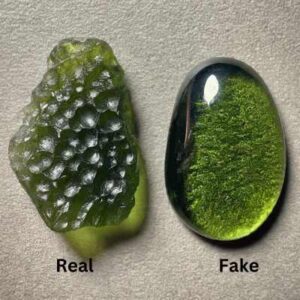Have you ever heard of a gemstone that originated from outer space? Moldavite, a rare and powerful gemstone, carries a fascinating history and intriguing metaphysical properties. This otherworldly gem has captured the attention of gemstone enthusiasts, spiritual seekers, and those interested in the mysteries of the universe.
Formed millions of years ago from a meteorite impact in what is now the Czech Republic, moldavite is believed to possess unique healing and spiritual growth properties. The green gemstone is associated with various chakras and has a significant presence in different cultures and zodiac signs. Its rarity and distinctive origin make it highly sought after, but this also makes it susceptible to imitation and fraud.
In this article, we will delve into the captivating history and discovery of moldavite, explore its metaphysical properties and significance in different cultures and zodiac signs, and discuss the identification of authentic moldavite versus imitations. Join us on a journey to uncover the secrets of this extraordinary gemstone from outer space.
The History and Discovery of Moldavite
Moldavite is a fascinating natural glass with a rich history, first recorded in 1787 when Professor Josef Mayer brought it to scholarly attention. Its roots, however, trace back to the Stone Age, where it served as tools for early humans. This olive-green stone, unique to the Czech Republic, has captivated people for centuries due to its believed connection to meteorite impacts creating its distinctive texture. Thought to be formed around 14.7 million years ago from molten debris flung into the atmosphere during a colossal meteoric collision, moldavite’s origin is not of this Earth.
This tektite’s strewn fields, from where it originates, span the regions of southern Bohemia to western Moravia, along with parts of Germany and Austria. Scientists have pinned the green stone’s composition to similarities with carbonaceous chondrites through beryllium isotope analysis, cementing its status as an extraterrestrial stone.
Table: Key Attributes of Moldavite
Attribute | Detail |
|---|---|
Color | Olive Green |
Region | Czech Republic (mainly southern Bohemia, western Moravia) |
Discovery | 1787 by Professor Josef Mayer |
Age | Approximately 14.7 million years |
Origin | Meteorite impact (associated with carbonaceous chondrites) |
Texture | Etched by CO2 and humic acids |
Moldavite’s intrigue not only lies in its cosmic roots but also in its alleged metaphysical properties aimed at fostering spiritual growth, particularly resonating with the heart and crown chakras. Despite its rarity, it’s important for enthusiasts to discern real moldavites from fake pieces and green glass imitations flooding the market.

The Metaphysical Properties of Moldavite
Moldavite’s enigmatic allure stems from its deeply interwoven relationship with the cosmos and its subsequent influence on holistic healing and spiritual evolution. As a talisman of profound transformation, it is regarded as a key instrument in helping the Earth transition into an elevated state of being. Within the heart of its glassy structure, Moldavite is said to harbor an intense vibration of spiritual protection, creating a barrier against negative energies and malevolent entities that might otherwise attach to a person’s aura.
Furthermore, this green stone is reputed to possess a cosmic oversoul, establishing a resonant channel to Ascended Masters and celestial messengers. It’s this connection that infuses Moldavite with the capability to attract positive thought patterns and light vibrations, essential for one’s ascension and enlightenment journey. Its high-frequency vibrations aid in unifying an individual’s consciousness with the Universal Source, thereby pushing the envelope of personal and spiritual growth.
Healing and Spiritual Growth Properties
The legend of the “Holy Grail Stone” follows the path of Moldavite, often cited for its extraordinary ability to fast-track one’s evolutionary progression. Its high vibrational frequency is said to weave a shield around its bearer, warding off spiritual pollutants. As a facilitator of deep communion with the divine, Moldavite can enhance meditation, making it easier to attune oneself with the highest aspects of the self.
The real magic of Moldavite lies in its remarkable spiritual properties. Believers claim it has the power to purify and balance chakras, especially aligning with the heart and third eye chakras, which form the core of emotional and intuitive energies, respectively. Working with Moldavite in practices such as meditation, dreamwork, or during any form of intuitive engagement, amplifies the user’s sensitivity to inner guidance, intuition, and even telepathy. It’s not just about personal development; this green crystal is also about understanding the greater cosmic messages meant to guide us through life’s journey.
Chakras and Moldavite
Moldavite plays an exceptional role when it comes to the chakras. Worn as jewelry, such as rings or necklaces, it is said to create a palpable spiritual connection as it aligns strongly with the Heart Chakra. The uplifting vibrations of Moldavite jewelry can pave the way for emotional openness and readiness for profound relationships while bolstering psychic abilities to perceive deeper truths of the universe.

In meditation, Moldavite’s high vibrations can act as a catalyst for the activation and alignment of the entire chakra system, dissolving obstructions and invigorating the flow of energy. Its resonance with the Heart Chakra promotes emotional healing, and its affinity with the Third Eye Chakra enhances introspection and psychic communication. Beyond its chakra-related effects, Moldavite’s energies are utilized effectively in more adventurous spiritual activities such as shamanic journeys and past life explorations, making it a versatile tool for both chakra work and expansive spiritual exploration.
Authentic vs. Fake Moldavite

In the realm of gemstones, Moldavite holds a place of intrigue not only for its unique formation but also for its striking appearance and purported metaphysical properties. Originating from the strewn fields of a meteorite impact in the Czech Republic approximately 15 million years ago, authentic Moldavite is a rare and distinctive natural glass that captivates collectors and spiritual enthusiasts alike. The allure of this olive green to dark-green gemstone has unfortunately given rise to a market replete with imitations that can mislead the uninformed buyer.
Identifying Genuine Moldavite from Imitations
To distinguish genuine Moldavite from fake pieces that commonly flood the market, there are key indicators to look for:
- Color Variation: Real Moldavite exhibits a range of green hues from olive to a rich, deep forest green. In certain lights, genuine Moldavite may even border on translucency. Counterfeit Moldavite tends to miss this spectrum, often portrayed as overly vibrant or unnaturally consistent in color.
- Surface Features: Authentic Moldavite has a distinctive matte finish, textured with inclusions and tiny gas bubbles known as lechatelierite. When examining the surface of the stone, these bubbles and the worm-like inclusions are often visible, which are challenging for fabricators of fakes to replicate authentically.
- Age Characteristics: Genuine Moldavite carries an aged look that comes from being a part of Earth’s geological history for millions of years. Fake Moldavite, by contrast, often looks too pristine, resembling shiny green glass without the weathered appearance of the real stones.
- Size and Price: Real Moldavites are typically smaller and carry a higher price due to their scarcity and origin from specific European regions. Oversized pieces with unusually low prices should be viewed with skepticism, as these are likely manufactured imitations.
- Origin Verification: Moldavite is sourced specifically from certain areas within the Czech Republic, Germany, and Austria. Any “Moldavite” from places like China, India, or Africa (often marketed as African Moldavite) is not genuine, as true Moldavite has a geographically confined strewn field linked to the Nördlinger Ries crater.
The Risks of Fake Moldavite
The consequences of acquiring fake Moldavite can be profound, especially for those invested in the metaphysical realm. Not only does fraudulent Moldavite lack the healing properties and energetic potential attributed to the true stone, but it can also lead to financial loss and disappointment.
- Authenticity: Buying from a non-credible source heightens the risk of ending up with a counterfeit that has none of the natural properties of Moldavite.
- Investment Loss: Collectors who mistakenly purchase fake Moldavite not only lose out on the spiritual and healing benefits but also incur a direct financial loss since fake Moldavite has little to no resale value.
- Market Impact: The prevalence of fake Moldavite can saturate the market, diminishing the perceived value of real Moldavite and harming the reputation of genuine vendors.
- Reduced Efficacy: For those who utilize Moldavite for its metaphysical properties, fake stones will not provide the anticipated energy or chakra alignment associated with true Moldavite, potentially undercutting an individual’s spiritual practice.
To safeguard against these risks, prospective buyers should only purchase Moldavite from reputable dealers who can provide certification of authenticity and detailed information on the stone’s origins. Conducting thorough research, being familiar with the characteristic features of real Moldavite, and exercising due diligence will help ensure that the Moldavite in your collection is as genuine and energetically potent as the beautiful green stones first formed by meteoric impact millions of years ago.
The Significance of Moldavite in Different Cultures and Zodiac Signs

Moldavite’s formidable presence stretches far beyond its geological formation, embedding itself in the diverse tapestry of cultural history and the cosmos. As a green stone born from the heat and force of a meteoric impact, Moldavite has been at the intersection of both earthly and celestial energies. Despite not being tied to a particular zodiac sign, it is universally revered as a creation of the stars, suitable for every astrological sign. The gemstone’s lack of specificity to any zodiac sign actually amplifies its allure, positioning it as a veritable stone of inclusivity, resonating with all individuals regardless of their astrological alignments.
Historically, Moldavite was cherished as a spiritual talisman by Neolithic peoples, valued for its potential to bestow good fortune and enhance fertility. It resonates with the heart of spring (April 20 – May 20), representing renewal and success in fresh undertakings, aligning well with the bursting vitality of this rejuvenating season. Moreover, Moldavite’s interaction with the heart chakra and its ability to activate the third eye and crown chakras point to its integral role in fostering vision, creativity, and spiritual enlightenment.
Indeed, Moldavite can be considered a mediator of human-life sources—conception and protection. Its role as a renewal gemstone equips it with neutral color vitality, indicating its importance across cultures. As a vital stone, Moldavite’s significance spans boundaries, applicable to various zodiac signs due to its connection with extraterrestrial origins and energies.
Moldavite in the Paleolithic Period
In the Paleolithic period, the allure of Moldavite captivated prehistoric humans, who discovered these green stones in the regions we now call the Czech Republic and Austria. Intrigued by their unique qualities, these early humans skilled in stone-working fashioned Moldavite into tools, leveraging the stone’s formidable hardness and sharp edges. The presence of Moldavite artifacts, dating back to the Aurignacian phase of the Upper Paleolithic era, underscores its long-standing utility.
The exchange and collection of these green wonders extended beyond their immediate areas of discovery. Findings reflect that Moldavite pieces were distributed far from their strewn field, suggesting a broad trade network that recognized the stone’s worth. It served not only as a functional tool material but also as an ornamental and ceremonial artifact, indicating a more profound cultural and religious significance that Moldavite held in those prehistoric times.
Moldavite and its Connection to Zodiac Signs
Moldavite’s relationship with the cosmic realm is as profound as it is unique. Unbound by traditional astrological assignments, Moldavite is agnostic to zodiac affiliations, rendering it a powerful entity for all signs. Its essence is in harmony with the theme of radical transformation espoused by springtime births (April 20 – May 20), making it a beacon of rejuvenation for individuals born during this time.
Known as a stone born of the stars, Moldavite carries within it energies for every zodiac sign. It’s not just for those seeking renewal but also for those embarking on new endeavors, requiring health invigoration, or undergoing a complete metamorphosis. Moldavite’s profound connection to the heart, third eye, and crown chakras offers a universal appeal—it is a stone with vibrational energies that catalyze spiritual growth and evolution, resonating with people across astrological lines.
In summary, while Moldavite’s vibrancy and extraterrestrial origins don’t make it exclusive to specific zodiac signs, its qualities are embraced by all, providing a unifying bridge between the earthly and the celestial, and between our past heritages and present quests for spiritual expansion.
Where Moldavite is Found and How it is Formed
Moldavite is an exceptional variety of tektite, primarily discovered in the Moldau River Valley within the Czech Republic. The region covering approximately a 40 square mile area is renowned for its deposits of this natural glass. Its name hails from the Moldau River, an area where these tektites are notably abundant. Moldavite’s formation can be traced back to approximately 15 million years ago, linked to a powerful impact event. During this catastrophic collision, believed to be a meteorite impact, the intense heat and force melted and fused surrounding silica sand and rock, catapulting the molten debris into the sky. As these particles cooled during their descent, they solidified into the glassy, green stones that are known as moldavites. This rapid cooling process was so swift that atoms were denied the ample time to organize into a regularly repeating pattern, rendering moldavite a mineraloid rather than a true mineral.
The Strewn Field and Moravian Moldavites

The tektites resulting from the meteoric event are not confined to the Czech Republic alone; fragments can also be found in parts of Germany and Austria. The distribution of moldavite, commonly referred to as the strewn field, is vast, encompassing the southern Moravia region of the Czech Republic, southern Bohemia area, Waldviertel in Austria, and extending to Lausitz in eastern Germany. This strewn field signifies the area over which the ejecta from the impact was dispersed, painting a picture of the event’s massive scale. Moravian moldavites are a special subset found in southern Moravia, identifiable by their vibrant green coloration, believed to be the most colorful of all impactites. These are specifically harvested from areas like the sand pits near Ločenice and Vrábče, and the clay pit near Besednice in southern Bohemia.
The Natural Glass and Molten Debris
Moldavite is distinct among the tektite group of natural glasses, which are products of interplanetary collisions. Its formation story is truly astronomical, with the substance believed to be created by the ferocity of an asteroid impact over 15 million years ago. The molten debris ejected during the incident is evidence of the intense heat involved; the glassy fragments that formed upon cooling were scattered over Europe. Moldavite is celebrated not just for its origin but also for its beauty. It’s the only tektite known to exhibit the translucent and lustrous green qualities that make it suitable for cutting and faceting into gemstones. This green crystal’s uniqueness is further highlighted by its scarcity; with millions of years of erosion and geological changes, much of the original moldavite material has either been eroded or buried, leaving an estimated total weight of 275 tons of this precious natural glass worldwide. Each piece of moldavite is singular, with a form that has been preserved since the time of its celestial birth.

Like many people, I began to search for answers to the deep questions of life, and the meaning of existence.
I sought out answers to “Who am I,” “Why am I here,” and “What was I sent to do?” The answer I found, and continue to find, can be summed up in 2 words: LOVE and LIGHT.
There is love in everything and everyone, and each of us is here to share that love with the world.
I am a spiritual healer and intuitive who has been using my healing gifts to help others.
